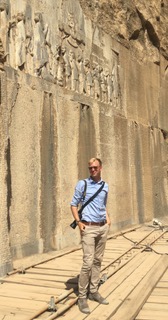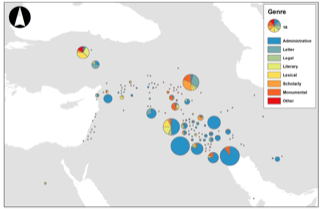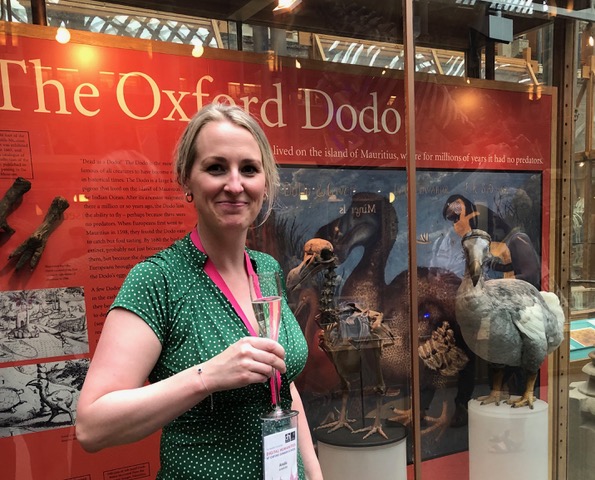The conference “Integrating Digital History, 3rd Digital History in Sweden Conference (DHiS2020)”, has published a Call for Papers. The deadline is on the 2nd of October 2020. Read more on the conference site!
Author: Matts Lindström (Page 2 of 2)
By: Lisa Börjesson/CAPTURE Project
Although the mantra of the CAPTURE project staff is that we’re curious about everything that could possibly count as information about data production and management processes, the researchers and professionals we meet have a different interest: What is paradata? And can you tell us how it relates to metadata? Most are less than satisfied with our indeterminate answers which are based on our mapping of the multiple meanings and usages of the term in archaeology and cultural heritage (forthcoming paper): paradata is a useful but also slippery notion that serves an array of purposes. Disappointing as our analytical take on the term may be for the ones who could have used a more clear-cut definition like yesterday, the interest in the term stimulates our continued work.
Some time has passed since CApturing Paradata for documenTing data creation and Use for the REsearch of the future (CAPTURE) was first introduced here at the Digital Humanities Uppsala Blog. Since then, Olle Sköld and Lisa Börjesson have joined the team as researchers. Also, we’re currently recruiting one fully funded Ph.D. student. Plus, in the coming years we’ll be recruiting two postdocs to the project. More on this later on!
In terms of research, two of the project’s larger data collection campaigns are at early stages. Firstly, we’re interviewing both makers and users of research data to better understand the production and use of information that detail data-production processes (‘paradata’) . Tips of possible informants, that is researchers with repeated experiences of depositing data and researchers with experiences of recurring analytical reuse of research data, are warmly welcome. Secondly, we’re designing a survey of paradata practices that will be open for respondents during fall 2020.

Interested in hearing more about our work?
- Isto Huvila will be heading a roundtable on paradata at the Computer Application and Quantitative Methods in Archaeology Conference 2020 14-17 April in Oxford.
- CAPTURE and URDAR will jointly present ongoing research at the Department of ALM’s higher seminar, Tuesday 28 April at 14.15.
- CAPTURE will invite participants to a full day of presentations and discussions about process information in archaeology at Uppsala University Monday April 20th 2020. Please contact us if you’re interested in joining this event!
This project is funded by the European Research Council (ERC) under the European Union’s Horizon 2020 research and innovation programme grant agreement No 818210.

I started out as an Assyriologist*, specializing in the world of cuneiform, a script in broad use across much of the Middle East from c. 3,300 BC until c. 100 AD. Not too many are studying it, and relatively few of that exclusive lot were doing much with a computer. Later, for my doctorate, I ventured into landscape archaeology, a field which had next to nothing to do with cuneiform, something my doctoral supervisor gently pointed out to me when he said that I had committed quite a career suicide by coming over. At least in the short term. For the first year, I locked myself into a basement trying to learn the basics of GIS and remote sensing, with a whole bunch of nerds who knew nothing whatsoever about cuneiform, but very much about exotic abbreviations such as GPS, GCPs, CRS, LIDAR, UAV, and DEMs, and compound curiosities like georectification, least-cost-pathways, viewscapes, panchromatic, and shapefile. I found myself constantly returning to my supervisor’s office half a day after each meeting we had, to say that we fundamentally misunderstood each other concerning whatever interface between philology and landscape archaeology we had last discussed.
Gradually, however, I also realized that each of those meetings produced something genuinely new because, being so wildly unfamiliar with common knowledge in each other’s fields, we constantly found ourselves asking new questions, addressing new issues, seeing new perspectives in matter otherwise all told and accounted for. A lot of this came straight out of the elementary yet stimulating challenge of how to integrate data and knowledge from very different fields of research within a common frame. And that’s what I found so immensely fascinating about digital fora in an academic setting, then and now. That subtle ability of a shared methodological or technical forum to bring different perspectives, different minds, different disciplines together, oftentimes for purposes that were rarely immediately clear to anyone involved. Thus, my doctoral dissertation came to deal with a very novel combination of quantitative approaches to data contained in a couple of thousand administrative texts – and settlement patterns as derived from spatial data sets that the nerds in the basement had been playing around with for years. The core argument was that, when properly scaled within a formal and coherent analytical frame, ancient texts could indeed be brought to bear on conclusions derived from satellite imagery and site mapping at a regional level. In my case casting some decent, and empirically solid, light on the material size of early state economies.

My current work at Uppsala University, and my engagement with Digital Humanities Uppsala, is very much a result of those early exposures to very different ways of studying and approaching the past. Our brand-new research project at Assyriology, funded by Riksbankens Jubileumsfond and called Geomapping Landscapes of Writing, or GLoW for short, aims to trace the distributional and compositional outlines of a discrete historical record, namely the cuneiform corpus, in its entirety. Counting perhaps half a million known texts, spanning a temporal transect of some 3,000 years, and traversing a geographical area reaching from the central Mediterranean to the eastern deserts of Iran, this corpus offers an opportunity to study the role of writing in early human history, its material distribution and composition, from a birds-eye perspective. Such an undertaking would have been unthinkable a decade ago, and its methodology owes as much to landscape archaeology as it does to cuneiform studies. Related ideas underpin the research network TextWorlds: Global Mapping of Texts from the Pre-Modern World, another new initiative that I am involved in, funded by CIRCUS, which will bring together philologists, archaeologists, and historians from across the university to discuss and explore shared traits between written corpora from around the world. A crucial basis for such initiatives is the ability to work from a shared, read digital, methodological platform able to capture vast amounts of data from seemingly disparate disciplines, each with their own way of approaching and studying the past, and oversee it within a shared frame of scholarly inquiry. So, over the next three years, I am looking forward to spending even more time lingering over applications, programs, and code with researchers from across the humanities and social sciences, debating, experimenting, and discovering new ways of fusing together our various specialties. From past experience, I would say that fora like Digital Humanities Uppsala are perfect for that sort of activity.
* Don’t worry if you don’t know what that is. Back in the pre-digital age, one of my teachers had been enrolled at Psychology for most of his undergraduate years because the university administration didn’t know either.
Maureen Ikhianosen Onwugbonu and Aikaterini Charalampopoulou, students at the DH Master’s Programme, recently published reports on their internships at Museum Gustavianium.
Read them here:
By Dr. Kerstin B Andersson, Dept. of Linguistics and Philology, Uppsala University / Swedish Council of Higher Education
I’m a media anthropologist and Indologist, currently working on the Indian diaspora and communication. During the last couple of years, I have focused my research on the distinct field of migration and the use of new media and social media, a growing academic field.
The impact and importance of the new technologies for migrants is well established. Appropriation of ICTs and new media environments have become a ubiquitous feature of everyday life in migrant groups. The development of the research field is closely related to the expansion of ICTs and new media. The first studies dealing explicitly with the field of migration and new media appeared in the end of the 1990s. Now, it has become an established academic research field.
Academic research in the field of migration and the use of new media is interdisciplinary, drawing on approaches from a number of subject areas, such as anthropology, migration studies, media and communication studies, studies in new science, Internet studies, sociology, and cultural studies. The research area is understudied, characterized by rapid changes and shifts, and is shaped by the changing structural conditions of migrants and the proliferation of forms of media. For example, the 2015 European refugee crisis led to a number of studies on the impact of new media on forced migration.
In a recent article, I provide a comprehensive overview of the rapidly expanding academic field of migration and the use of new media. So far, the research field has been characterized by an increasing number of empirical case studies on the use of new media in migrant groups. Through a review of the existing literature in the field, I provide an inclusive narrative synthesis of the academic field. The result is presented in the form of a narrative literature review, where I elaborate on the status of the research field, the primary themes and topics of research interest, the theoretical and conceptual issues under investigation, and the methodological approaches to research in this field.
Link to the full article: https://humantechnology.jyu.fi/archive/vol-15/issue-2/digital-diaspora

By Amalia Juneström, Department of ALM, Uppsala University
My name is Amalia, and I’m a PhD student from the Department of ALM at Uppsala University. Thanks to a grant from Riksbankens Jubileumsfond – The Swedish Foundation for Humanities and Social Sciences – which allows researchers to attend the annual summer school for the digital humanities at Oxford University, I had the privilege of participating in the week-long summer school in Oxford earlier this summer.
When I left for Oxford, I had already been involved in the planning of our own new international and interdisciplinary digital humanities master’s programme, which will start in our department this autumn. It has been an enjoyable experience, and I was looking forward to participating further. However, although I was well aware of the increasing role played by tools and techniques from the digital humanities field within my own discipline, my relationship to them had so far been tangential. To tell the truth, my own experience of many of the new computer-based techniques used within both my own field and the digital humanities had been one based on a mixture of fascination and trepidation. In short, I felt an urgent need to broaden my understanding of this knowledge domain; the opportunity to participate in a one-week introduction course was therefore much appreciated.
The summer school offered a variety of strands providing insight into different domains of knowledge within the digital landscape. In order to improve my general understanding of the digital humanities, I chose the strand ‘An Introduction to Digital Humanities’. In terms of participant numbers, this strand turned out to be by far the largest within the summer school, and it was well suited for those who, like me, wanted to better acquaint themselves with the tools and methods found within the interdisciplinary field of the digital humanities. Unlike the other workshop-based strands, which offered hands-on practical training in the techniques and tools of each course, the strand that I chose was mainly lecture based, making it well suited to beginners. By drawing on expertise from many different fields, the lectures offered insight into a range of research approaches embraced by the digital humanities.
During the five days of the summer school, we checked out a selection of research scopes such as text mining, digital archiving and musicology. I think that everyone who participated found it useful to go through such a wide variety of topics, digital tools and methodological spheres of application. All in all, I found the selection of themes and topics at the summer school very well organised and rewarding. Also, I am truly convinced that location and setting can have a great impact on the outcomes of learning, and what location could be better for acquiring new knowledge than Oxford, one of the world’s most famous centres of learning? But even if you don’t believe there’s a connection between location and successful learning, the historical setting made the experience highly memorable, and I really appreciated our accommodations in the romantically Victorian red-brick Keble college, whose historical atmosphere was reminiscent of Brideshead Revisited.
By attending the summer school, I definitely acquired a better understanding of some of the research methods and techniques which are important within my own research field and which are of interest to my own academic journey. I would like to thank Riksbankens Jubileumsfond for the opportunity to take part in the summer school, and I encourage everyone who has an interest in the digital humanities to check out the programme for next year’s summer school and apply!


